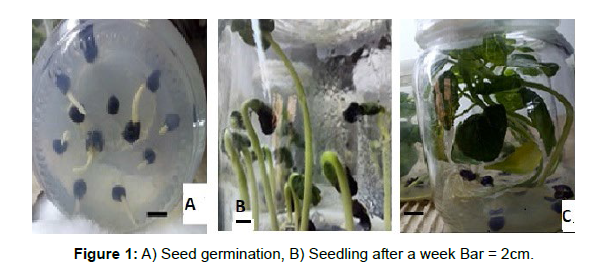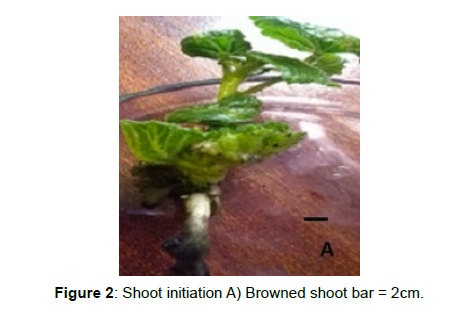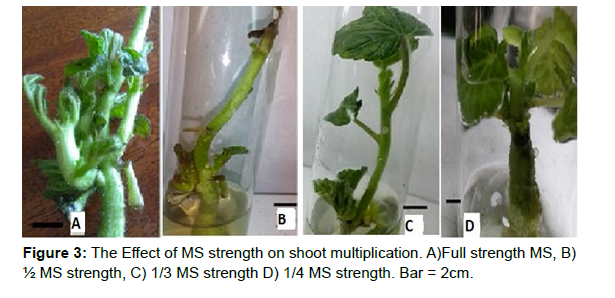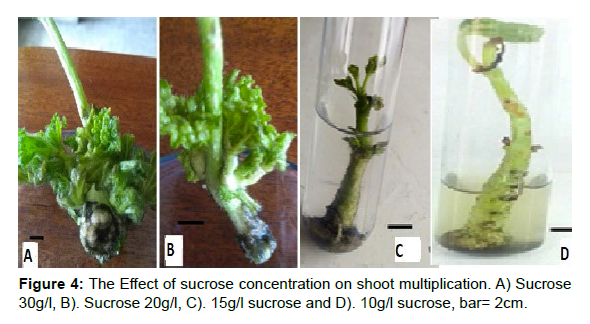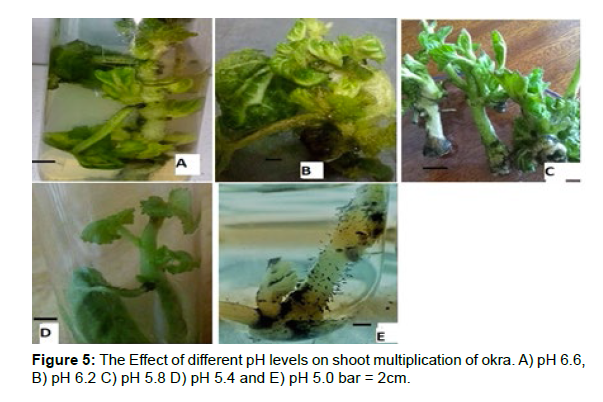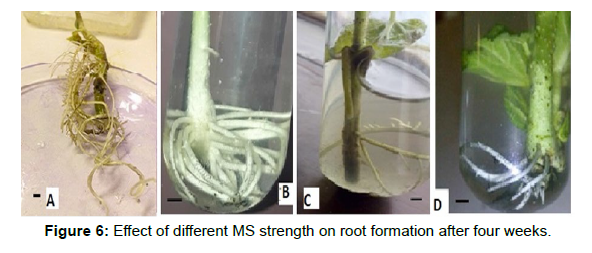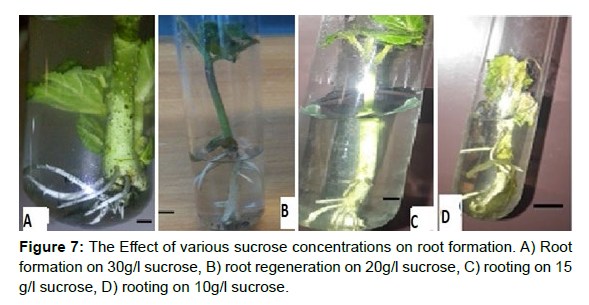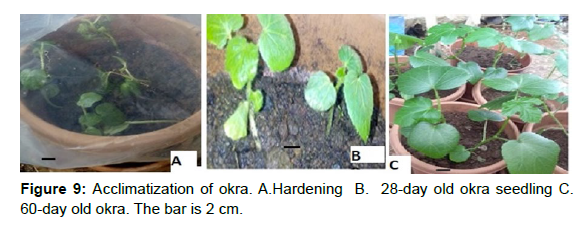The Effect of MS strength, pH and Sucrose Concentrations on In vitro Propagation of Okra (Abelmoschus esculentus L.) from Shoot Tip Explants
Received: 01-Mar-2023 / Manuscript No. jbtbm-23-88145 / Editor assigned: 03-Mar-2023 / PreQC No. jbtbm-23-88145 (PQ) / Reviewed: 17-Mar-2023 / QC No. jbtbm-23-88145 / Revised: 22-Mar-2023 / Manuscript No. jbtbm-23-88145 (R) / Published Date: 28-Mar-2023 DOI: 10.4172/2155-952X.1000321
Abstract
Background: Okra (Abelmoschus esculentus) is belongs to the family Malvaceae and genus Hibiscus. Conventional propagation of okra in a large scale is limited due to bacterial, fungal, viral disease and seed dormancy. Hence, micropropagation offers great potential to increasing the commercial availability of okra. This study aimed to investigate the effect of MS strength, sucrose concentration, and pH on the in vitro propagation of A. esculentus from shoot tips.
Results: Okra seeds were sterilized with 70% alcohol, 30% (v/v) Berekina and 0.13% HgCl2 (w/v) for 5, 40 and 10 minutes respectively. The shoots were excised from in vitro germinated seedlings and transferred to full strength MS liquid medium containing 1mg/L BAP. The in vitro initiated shoot tips were transferred to different MS strength (1, ½, ⅓, ¼) medium, sucrose concentration (30 g/L, 20 g/L, 15 g/L, 10 g/L) and pH level (pH 6.6, 6.2, 5.8, 5.4, 5.0) that contained 1.5 mg/L BAP and 200 mg/L activated charcoal. For rooting, different MS strength (full, ½, ⅓, ¼), sucrose (30 g/L, 20 g/L, 15 g/L and 10 g/L) and pH (6.6, 6.2, 5.8, 5.4, 5.0) that contained 1mg/L IBA with 200 mg/L activated charcoal were used. Full strength MS medium containing 30 g/L sucrose at pH 5.8 produced the highest mean shoot number (7.93), mean leaf number (14.37) and mean length (6.4 cm) per explant. Similarly, at pH 6.2 and 6.6 maximum shoot mean number (6.53, 5.80), leaf number (12.77, 10.43) and shoot length (6.32, 5.82 cm) were produced respectively. Maximum mean root number (15.73) and root length (6.05 cm) were recorded at ½ MS strength. At pH 5.8, 6.2 and 6.6 maximum mean root number (1.77, 1.47, 1.80) and root length (1.38, 1.25, 1.39 cm) were obtained. After acclimatization, 86% of plants survived in greenhouse.
Conclusion: Decreasing the MS strength, sucrose concentration and pH level had an inhibiting effect on both shoot multiplication and root formation of okra. Besides increasing pH value showed inhibiting effect on shoot multiplication.
Keywords: Abelmoschus esculentus; Micropropagation; MS medium; pH; Salt strength
Keywords
Abelmoschus esculentus; Micropropagation; MS medium; pH; Salt strength
Introduction
Okra (Abelmoschus esculentus) is belongs to family Malvaceae genus Hibiscus. Later delimited in a genus named. According to Siemonsma, this genus encompasses 14 species with several subspecies. Okra is widely distributed from Africa to Asia, subtropical and warm temperate regions around the world. Although the plant grows fast in well-drained humus-rich fertile soil, in full sunlight, humid and upland areas, okra tolerates a wide range of soil types and pH from 5.5 to 8.0. The plants grow best during the warm months. In the tropics, this plant can flower throughout the year and continuously harvested. Okra is a dicotyledonous and largely self-pollinated herbaceous plant mostly with annual but rarely perennial habit often with various range of chromosome number but 2n=4x =130 is the most common one has a deep taproot, the stem is erect, stout, robust, leaves are around 10–20 cm long, flowers of okra are axillary and solitary. The pod or fruit is 10 to 25 cm long containing numerous oval, kidney-shaped seed.
Okra has various local names in different countries. In many English speaking countries, it is known as okra, ladies finger, and gumbo. In Ethiopia, it is known as Bamia (in Oromiffa/Amharic/ Tigrigna), Kenkase (in Berta), Andeha (in Gumuz) languages.
At the varied stage of growth, different parts of okra plants have food, non-food and medical applications. Okra immature fruits are used in salads, soups and stews. Hulls and fiber can be used for animal feeds. Moreover, okra’s tender fruit, seeds and leaves are endowed with low saturated fat, cholesterol, various minerals (like calcium,phosphorus, iron, sodium, potassium, copper, sulfur), starch, valuable phenolics, flavonoids, antioxidants, dietary protein and fiber, Vitamin A, thiamine, riboflavin, nicotinic acid, and Vitamin C. There is no toxic substance reported in the edible part of okra .
Okra consumption prevents several ailments such as gastro intestinal tract disorders (diarrhea, dysentery diabetes, irritation of stomach and bowel, sore throat), respiratory disease (lung inflammation, catarrhal infections), sexual transmitted disease (syphilis, gonorrhea), renal disfunction (renal tubulointerstitial disease, dysuria, and irritation of kidneys), hepatitis, cancer, ulcers, and okra mucilage have been reported to have a strongly demulcent action and used as a plasma replacement, washing away toxic substances and bad cholesterol.
Okra is propagated sexually using seeds. Conventional propagation of okra in a large scale is limited due to bacterial, fungal, viral disease and seed dormancy which result in great economic losses. Therefore, micropropagation offers great potential to overcome such problems and increasing the commercial availability of such useful species.
In vitro propagation of A. esculentus is reported by using explants such as cotyledonary node, nodal segment and shoot tips of in vitro grown seedlings, hypocotyl, cotyledon, cotyledonary node and leaf segment by varying growth regulators and using additives. Successful regeneration of this plant is an elusive process because of exudation of phenolic compounds, tissue browning, and necrosis of explants, media composition, culture conditions, carbon sources, and culture vessels.
Therefore, considerable efforts are still required to discover efficient in vitro propagation methods of this nutritionally and medicinally enriched plant. As to our knowledge, there are no reports on the effect of different MS strength, various sucrose concentration and different pH levels for in vitro propagation of A. esculentus on both liquid and solid media of Ethiopian okra. Thus, this study was intended to investigate the effective of MS strength, sucrose concentration and pH level on in vitro propagation A. esculentus from shoot tip explants in liquid media so that to optimize best basal medium (MS) strength for shoot multiplication and rooting of A. esculentus from shoot tip explants, to determine the optimum concentration of sucrose for multiplication and rooting of in vitro rooted A. esculentus plantlets and to optimize the best pH protocol for the multiplication and growth of A. esculentus in liquid media [1-4].
Results
Surface sterilization of seed and in vitro seed germination
Surface sterilization of seeds after the subsequent washing with 70% alcohol for 5’, 30% (v/v) Berekina for 40’ and 0.13% mercuric chloride for 10 minutes was effective to reduce microbial contaminants. Among the total 240 seeds, 204 (85%) seeds germinated and were free from contamination. Seed germination started after 3-4 days (Figure 1).
Shoot initiation
The shoot tips after 28 days showed multiplication and increased in size (3-4cm) and some explants showed necrosis symptom and brewing. However, 24 explants (80%) were initiated normal (Figure 2).
Shoot multiplication
Effect of MS strength on shoot multiplication
The effect of different strength of MS media on shoot multiplication had shown at (Table 1 and Figure 3) Explants cultured on 1/4 MS media exhibited a morphological change like thick, shiny, swollen media dipped, and normal leaves but never showed shoot multiplication.
Treatment |
Mean Shoot No./explant | Mean Leaf No./explant | Mean Shoot length/explant |
|---|---|---|---|
| Full MS | 7.93a ± 0.656 | 14.37a± 1.153 | 6.4a ± 0.350 |
| ½ MS | 2.13b ± 0.171 | 4.43b ± 0.403 | 4.10b ± 0.304 |
| 1/3 MS | 1.30b ± 0.085 | 2.80b ± 0.139 | 3.43bc±0.108 |
| 1/4 MS | 1.00b ± 0.00 | 3.40b ± 0.170 | 2.92c ± 0.033 |
Means within columns having the same superscript letters are not different at p<0.05.
Table 1: Effect of different MS strength on shoot multiplication.
Effect of sucrose concentrations on shoot multiplication
The effect of different sucrose concentration with full MS media on shoot multiplication of A. esculentus had shown at Table 2 and Figure 4. The shoot tip explants respond poorly at 10g/l and 15g/l sucrose concentration.
Sucrose (g/l) |
Shoot No /explant | Leaf No / explant | Shoot length/explant |
|---|---|---|---|
| 30 | 7.93a ± 0.656 | 14.37a ± 1.153 | 6.4a ± 0.350 |
| 20 | 2.20b ± 0.169 | 5.53b ± 0.224 | 5.26b ± 0.274 |
| 15 | 1.20bc± 0.074 | 3.93b ± 0.197 | 3.52c ± 0.095 |
| 10 | 0.67c ± 0.088 | 1.13c ± 0.164 | 2.37d ± 0.212 |
Means within columns having different superscript letters are different at p<0.05.
Table 2: Effect of different sucrose concentration on shoot multiplication of okra.
The effect of pH on shoot multiplication
This study showed that media pH had a significant effect on shoot multiplication of okra. Morphogenetic responses of shoot tip explants (Figure 5) at different pH level had shown in Table 3. Shoot explants cultured at pH 5.0 showed poor response and necrosed gradually.
| Treatment | Mean Shoot No /explant | Mean Leaf No / explant | Mean Shoot length/explant |
|---|---|---|---|
| pH 5.0 | 0.10c ± 0.056 | 0.13c ± 0.097 | 0.30c ± 0.167 |
| pH 5.4 | 1.13c± 0.150 | 2.60c ± 0.351 | 2.57b ± 0.293 |
| pH 5.8 | 7.93a ± 0.656 | 14.37a ± 1.153 | 6.36a ± 0.350 |
| pH 6.2 | 6.53ab ± 0.462 | 12.77ab ± 0.650 | 6.32a± 0.324 |
| pH 6.6 | 5.80b ± 0.458 | 10.43b ± 0.744 | 5.82a ± 0.298 |
Means within columns having different superscript letters are different at p<0.05.
Table 3: Effect of different pH level on shoot multiplication of okra.
Rooting
Effect of MS strength on rooting
The impact of different MS strength on root formation had shown clearly at table 4 and Figure 6. The maximum mean root number (15.73) and mean root length (6.05 cm) was obtained on half strength MS medium. The least mean root number (0.70 ± 0.187) and mean root length0.54 ± 0.124 cm was recorded on one fourth MS strength medium.
| Treatment | Mean Root No /explant | Mean Root length/explant |
|---|---|---|
| Full MS | 1.77c ± 0.338 | 1.38c ± 0.249 |
| ½ MS | 15.73a ± 1.050 | 6.05a ± 0.330 |
| 1/3 MS | 7.50b ± 0.628 | 2.65b ± 0.167 |
| ¼ MS | 0.70c ± 0.187 | 0.54c ± 0.124 |
Means within columns having different superscript letters are different at p<0.05.
Table 4: Effect of different MS strength on root formation.
Effect of sucrose on rooting
Varying the concentration of sucrose on in vitro root formation and proliferation had a determinant effect. As indicated on table 5 and figure 7, root formation was observed on medium containing 30 g/l sucrose with a mean root number of 1.77 and mean root length of 1.38 cm. The least mean root number (0.60, 0.53) and mean root length (0.30, 0.37 cm) was recorded on medium containing 15g/l and 10g/l sucrose concentration respectively.
Sucrose concentration (g/l) |
Mean root No. /explant | Mean root length/explant (cm) | ||
|---|---|---|---|---|
| 30 | 1.77a ± 0.338 | 1.38a ± 0.249 | ||
| 20 | 1.33ab ± 0.301 | 0.87ab ± 0.180 | ||
| 15 | 0.60b ± 0.189 | 0.30b ± 0.092 | ||
| 10 | 0.53b ± 0.184 | 0.37b ± 0.131 | ||
Means within columns having different superscript letters different at p<0.05
Table 5: Effect of various sucrose concentrations on root formation of okra
Effect of pH on rooting
The pH level had a determinant effect on the formation of the root As shown in table 6 and figure 8, at pH 6.6, pH 5.8 and pH 6.2 root formation has been observed with a mean root number (1.80, 1.47) and mean root length (1.39, 1.38, 1.25 cm) respectively. There was no root formation at pH 5.0. The browned explant at pH 5.4 showed 0.53 mean shoot number per explant and 0.42 cm shoot length.
pH |
Root No /explant | Root length/explant |
|---|---|---|
| 5.0 | 0.00b ± 0.00 | 0.00b ± 0.00 |
| 5.4 | 0.53b ± 0.164 | 0.42b ± 0.155 |
| 5.8 | 1.77a ± 0.338 | 1.38a ±0.249 |
| 6.2 | 1.47a ± 0.261 | 1.25a ± 0.225 |
| 6.6 | 1.80a ± 0.264 | 1.39a ± 0.218 |
Mean within columns having different superscript letters are different at p<0.05
Table 6: Effect of pH on root formation.
Acclimatization
Among 50 well-rooted explants from ½ half MS strength and one third MS strength acclimatized in the greenhouse, 43 (86%) survived (Figure 9).
Discussion
Seed germination and shoot initiation
Surface sterilization of seeds with 70% alcohol for 5 minutes, 30% Berekina for 40 minutes and 0.13% mercury chloride for 10 minutes were effective to reduce microbial contaminants with 85% germination of seeds.
Using full MS media supplemented with 1mg/L BAP, 80% explants from shoot tips were initiated well. According to Okra, 75% shoots were initiated from shoots tip explants of A. esculentus. The result difference is might be related to hormonal concentration and the use of agar gelling agent which affect nutrient absorption the plant.
Shoot multiplication
Effect of MS strength on shoot multiplication
Success in the in vitro propagation of a germplasm depends on its genotype, age, type of tissue etc. different studies showed that, in vitro propagation of A. esculentus was investigated well on the standard MS basal solid media enriched with 30g/L sucrose at pH 5.8.
The MS strength and medium consistency directly influenced in vitro morphogenic responses in A. esculentus shoots. Shoot tip of explant cultivated on full MS liquid medium had highest mean shoot numbers (7.93), mean leaf number (14.37) and mean shoot length (6.4 cm) per explant. Whereas the least mean shoot number (1.0), mean leaf number (3.40) and mean shoot length (2.92 cm) were recorded on ¼ MS strength where each MS strength was enriched with 1.5 mg/L BAP, 30 g/L sucrose and 200 mg/L activated charcoal at pH 5.8.
The result in the present study indicating that MS strength has its own toll in optimizing the regeneration protocol. According to Dahab et al. and Zayova et al. from in vitro propagation of Ruscus hypoglossum L. and Arnica montana L. similar results were reported. In contrary to this result, the study on Hibiscus syriacus L. and Drosera intermedia using 3/4 MS and 1/8 MS strength medium revealed the highest shoot length, shoot number and the highest number of leaves per explant respectively. This indicated that, shoot regeneration not only affected by MS strength but also media composition, explants type, age, genotype, growth regulators, and culture condition. Out of the MS strength considered, explants cultured on half MS strength did not regenerate quality shoots rather it began wilt at the tip of the shoot, Explants cultured in ¼ MS strength exhibited thick, shiny, swelled at the excised and media dipped area of the explant. Likewise, in ¼ MS strength, explants were initially endowed with healthy leaves though they were dropped off after a few days. All these effects showed that, the variation of MS strength had a significant role for the growth of plant.
Effect of Sucrose on shoot multiplication
In plant tissue culture, sucrose serves as a carbon and energy source. In this study, the highest mean shoot number (7.93), mean leaf number (14.37) and mean shoot length (6.36) were recorded on MS medium enriched with 30g/L sucrose and the lowest mean shoot number (0.67), mean leaf number (1.13) and mean shoot length (2.37) were obtained from MS medium containing 10g/L sucrose. There was a significant difference between 30g/l and 20g/l, 15g/l and 10g/l sucrose concentration on in vitro shoot multiplication of A. esculentus. On medium containing 10g/l and 15g/l sucrose, explants failed to regenerate leaves and showed shoot tip necrosis. This result indicted that, reducing sucrose concentration had direct impact on cellular division due to insufficient carbon source and energy, hence result poor shoot regeneration and growth of A. esculentus. An experiment on Ruscus hypoglossum and Cornus alba L. revealed the same trend to this result. According to Rejthar et al. the highest mean shoot length and mean shoot number recorded on liquid medium containing 10g/l and 20 g/l respectively from Drosera intermedia. This difference is caused by genotype, growth regulators and culture conditions.
Effect of pH on shoot multiplication
Plant tissues can maintain a relatively constant cytoplasmic pH across an external pH range of 4 to 9. Too low pH converts inorganic phosphate into organic phosphate at the extracellular region which reduces the availability of ATP and so it limits plant growth. It is established fact that okra plant is known to tolerate pH of 5.5-8.0 under in vivo condition.
In this study, the effect of media pH on in vitro propagation of okra was investigated at different pH levels (5.0, 5.4, 5.8, 6.2. and 6.6). The highest mean shoot number (7.93, 6.53) and mean leaf number (14.37, 12.77) was recorded at pH 5.8 and 6.2 whereas highest mean shoot length (6.36, 6.32, 5.82 cm) was recorded at pH 5.8, 6.2 and 6.6 respectively. The least shoot multiplication was recorded at pH 5.0 with mean shoot number (0.10), mean leaf number (0.13) and mean shoot length (0.30 cm) and all showed necrosis after 28 days. Explants cultured at pH 5.4 exhibited low shoot multiplication with necrosis at the shoot tip of explant. In vitro propagation of okra at pH 5.8 and 6.2 had no significant difference at P ≤ 0.05. This result indicated that, low pH limit shoot regeneration of the plant by affecting nutrient and growth hormone absorption. Work on the effect of media pH on in vitro propagation of Cornus alba L gave similar result to the present study. According to Rejthar et al. from in vitro propagation of Drosera intermedia, highest shoot number recorded at pH 4.7 which is unrelated to the present study because of the difference in culture condition, genotype and growth regulators.
Rooting
Effect of MS strength on rooting
In vitro rooting of shoot mostly depends upon concentration and duration of auxin treatment and salt strength of the basal medium. Hinnen et al. stated high concentration of salts may inhibit root growth, even in the presence of auxins in the culture medium. Reducing the concentration of macro and micronutrients to half of their normal concentrations during the rooting phase of most plant species is important.
In this very study, vigorous root proliferation was observed on half strength MS medium with mean root number of 15.73 and mean root length of 6.05 cm. The least and weak root formation and proliferation were observed on ¼ MS strength with a mean root number (0.70) and mean root length (0.54 cm) in the medium enriched with 1mg/L IBA, 200 mg/L A.C and 30 g/L sucrose. In some explants there were lateral roots with more fibrous root hairs. In other explants roots were emerged and proliferated by forming four-line each containing at least five roots with no root hairs. Roots formed in 1/3 MS strength had many nodules with no root hairs. In root initiation experiment on Ruscus hypoglossum, Drosera intermedia and A. esculentus, the highest root number and length recorded on ½ strength MS media which is corelated to the present study. Micropropagation study on Arnica montana L. according to Zayova et al. The highest mean number and mean root length of roots per plant was recorded on ¼ strength MS medium while the lowest root number and root length on full strength MS medium which is contradicting with the present study due to the difference in explant, genotype, age and media composition to each MS strength treatment.
Effect of sucrose concentration on rooting
This study indicated that not only MS salt strength had a determinant effect on root formation but also varying the concentration of sucrose plays an important role in in vitro root formation and proliferation. In our experiment, the highest root number (1.77) and root length (1.38 cm) per explant was recorded at 30g/L sucrose compared to 20g/l, 15g/L and 10g/l sucrose concentration. The least root formation was observed at 10g/L and 15g/L sucrose concentration with mean root number (0.53, 0.6) and mean root length (0.37, 0.3 cm). According to Baksha et al. the best root number and root length recorded at 50g/L sucrose from in vitro rooting of Saccharum officinarum. Also, the highest root numbers at 10 g/L sucrose were reported from rooting experiment on Drosera intermedia. both results are different to the present study. The difference brought by media composition, age of the explant, growth regulators and genotype difference.
Effect of pH on rooting
At pH 6.6, pH 5.8 and pH 6.2 a relative root regeneration had been observed with a mean root number (1.80, 1.77, 1.47) and mean root length (1.39, 1.38, 1.25 cm), respectively. On the other hand, the least mean root number of 0.53 and mean root length of 0.42 cm was recorded at pH 5.4. Whereas at pH 5.0, explants necrosed with no root formation. This result showed that, decrease in pH had negative impact on root initiation and growth of the plant. Similar results reported as to the current result from experiment on Saccharum officinarum. However, the highest root number at 7.7 pH and root length at pH 4.7 on Drosera intermedia was reported which is different from the present study. This is due to difference in genotype, growth regulators and culture condition.
Acclimatization
Well rooted explants transferred into pots containing autoclaved (sterilized) sand, red soil and compost at a ratio of 2:1:1 respectively. The plantlets were covered with transparent polyethylene bags to maintain moisture placed in growth room for hardening for four day and directly transferred into the greenhouse which has slightly hot temperature and humidity. The plantlets showed 86% survival rate which is more probably agreed to who got 87% survival of A. esculentus.
Conclusion
Large-scale multiplication of A. esculentus by tissue culture methods is feasible and several plantlets can be regenerated from a single shoot tip explant. The effect of MS strength along with 1.5 mg/L BAP, 30g/L sucrose and 200 mg/L activated charcoal on shoot multiplication was highly significant (P ≤ 0.05). The maximum shoot number, leaf number and shoot length was obtained from full strength MS medium. Moreover, the culture also best responded to 30g/L sucrose and at pH 5.8, 6.2 and 6.6 whereas the best root formation and proliferation was obtained at ½ MS strength supplemented with 1.0 mg/l IBA, 30 g/l sucrose, 200 mg/l activated charcoal at pH 5.8. The cultures also showed good adaptability to low-level pH and MS strength and low-level sucrose concentration. This implies that this protocol enables the mass propagation of A. esculentus from shoot tip explant. Therefore, further optimization of this protocol may be required for mass propagation of this plant. It is recommended that other methods to practice like explants other than shoot tips culture for in vitro propagation of A. esculentus, further studies on the performance of the tested cytokinins in combination with other type of hormone for better result on shoot multiplication, identifying an optimum sub-culture of the micro shoots should be carried and the effect of different concentrations of auxins on induction of roots should be further studied. It is also recommended to practice other techniques like photoautotrophic culturing of explants for mass propagation of A. esculentus. The result of the present study will have its own contribution to improving multiplication, genetic transformation, and conservation of A. esculentus [5-7].
Methods
Source of explant, seed surface sterilization and in vitro seed germination
An esculentus seeds were collected from Assosa Agricultural Research Centre in Benishangul Gumuz Regional State during 2016 which has permission from Ethiopian Institute of Agricultural Research (EIAR). The collected specimens were identified and confirmed by the botanist before we did the further experimental analysis. The seed were sterilized by washing the seeds with running tap water followed by 30 % commercial bleach, Berekina (v/v) for 40 minutes followed by thorough washing by distilled water five times before taking to laminar airflow hood. In the hood, the seeds were initially treated with 70% ethanol for 5 minutes and then washed three times with autoclaved distilled water and again treated with 30% (v/v) Berekina for 40 minutes and washed by sterilized water and treated by 0.13% HgCl2 (w/v) for 10 minutes, finally washed with sterile distilled water to be ready for culture.
For in vitro seed germination, 12 surface sterilized seeds were cultured per culture vessel containing 50 ml growth regulators free full-strength MS medium. The MS medium was enriched with 30 g/L sucrose (w/v), 7 g/L agar (w/v); pH was adjusted to 5.8 and autoclaved at 121ºC for 15 minutes. The cultures were transferred and randomly placed on the growth room shelf that had a light intensity of 16-hour photoperiod provided by cool-white fluorescent lamps at a temperature of 25±2ºC.
MS stock solution preparation
In this study, Muragshige and Skoog basal medium was used. The stock solution of macronutrients, micronutrients, iron, and vitamins were prepared independently. The appropriate amount of each nutrient was measured in grams per liter and dissolved in distilled water then subjected for continuous agitation using a magnetic stirrer till all the components were completely dissolved. Afterwards, the solution was poured into plastic bottles and macronutrient and micronutrient were stored at -20°C whereas the iron EDTA and vitamins were stored at +4°C to be used for a maximum of one month.
Plant growth regulators stock solution preparation
BAP and IBA were used with the same concentration for all treatment, i.e. 1.5 mg/L BAP for shoot multiplication and 1.0 mg/L for IBA for rooting. Each of these plant growth regulator stock solutions was prepared by weighing and dissolving the powder in distilled water at a concentration of 1.0 mg/mL. To begin the dissolving process 3-4 drops of 1M NaOH or 1M HCl were added based on the growth regulators (NaOH for auxin, HCl for cytokinin). Then, the volume was adjusted by adding distilled water. Finally, growth regulators stock solutions were stored in a refrigerator at a temperature of +4°C until used.
Culture media preparation
Culture media were prepared by mixing the appropriate MS stock solutions (50 ml/L macronutrient, 5 ml/L micronutrient, 5 ml/L iron EDTA and 5 ml/L vitamin) with 30 g/L sucrose. The optimized growth regulators concentration for shooting and rooting, i.e. 1.5 mg/L for BAP and 1,0 mg/L for IBA, respectively, were added and stirred until mixed completely. The volume of the media was adjusted by adding distilled water. The pH was adjusted to 5.8. Finally, 7.0 g/L agar was added only for seed culture. After the melting of agar formation of clear solution, 50 ml medium was dispensed into each culture vessel. Full MS solid medium was used for in vitro seed germination. However, 5-10 ml liquid medium was dispensed to each culture vessel tube for shoot initiation and multiplication. Both types of media were sterilized by autoclaving at a temperature of 121°C at a pressure of 105 KPa for 15 min. Finally, the medium was cooled in the laminar airflow cabinet. To obtain pertinent data, full MS, ½MS, ⅓MS, and ¼MS were prepared with the objective of optimizing the best MS strength for in vitro propagation of A. esculentus. Similarly, 30 g/L, 20 g/L, 15 g/L and 10 g/L sucrose and 6.6 pH, 6.2 pH, 5.8 pH, 5.4 pH and 5.0 pH were used. Besides, 200 mg/L activated charcoal (AC) was added to the medium.
Shoot initiation
About 1.5-2.5cm shoot tips from in vitro germinated seedlings were excised and cultured in liquid MS medium supplemented with 1.0 mg/L BAP alone and 30 g/L sucrose (w/v) and the pH was adjusted to 5.8 in full strength MS medium. One explant was cultured in one test tube and a total of 30 test tubes were used. The cultures were maintained in culture room under light intensity of 16 h photoperiod provided by white fluorescent lamps at a temperature of 25±2ºC.
Shoot multiplication
The in vitro initiated shoots were transferred to different MS strength (full, ½, ⅓, and ¼), different sucrose concentration (30 g/L, 20 g/L, 15 g/L, and 10 g/L) and at different pH levels (6.6, 6.2, 5.8, 5.4 and 5.0) supplemented with 1.5 mg/l BAP to determine the effect of each variable on multiple shoot formation. In this study, 30 samples for each treatment contained one shoot tip explant per culture tube were used. The cultures were maintained at 25°C ± 2°C with a 16 h photoperiod and sub-cultured every two weeks. Shoot length, the number of leaves and the number of shoots per explant were recorded after four weeks.
Rooting
Shoots from multiplication media were transferred to rooting medium. The rooting medium was obtained different MS strength (full, ½, ⅓, and ¼), full MS strength at different sucrose concentrations (30 g/L, 20 g/L, 15 g/L, and 10 g/L) and pH level (6.6, 6.2, 5.8, 5.4 and 5.0) supplemented with 1 mg/L IBA and 200mg/L AC. One shoot was cultured in each test tube in 30 replications. The cultures were maintained in the growth room under the same condition as of shoot multiplication. The number of roots per shoot and root length were recorded after four weeks.
Acclimatization
Plantlets with well-developed shoots and roots were carefully separated from the root inducing culture vessel tube and transferred to pots containing autoclaved sand, red soil and compost at 2:1:1 ratio, respectively. The plantlets were covered with transparent polyethylene bags to maintain moisture and directly transferred into the greenhouse. The plantlets were watered in the afternoon once per day for five days and then watered once every two days. Polyethylene bag was gradually removed after two weeks and the number of survived plants was recorded after four weeks.
Experimental design and statistical data analysis
After four weeks, the transferred explants into multiplication media (number of shoots per explant, mean shoot length and number of leaves) and rooting media (number of roots per shoot, and mean root length) were recorded. A completely randomized design (CRD) was used for all experiments. Data were subjected to analysis of variance (ANOVA) and the least significant difference (LSD) and Tukey’s test using statistical data analysis SPSS software for windows (ver.26) at 0.05 probability level [8-10].
Abbreviations
AC Activated charcoal
BAP 6- Benzyl amino purine
CRD Complete Random Design IBA Indole-3- butyric acid
LSD Least Significance Difference
MS Muragshige and Skoog, (1962)
SPSS Statistical Package for Social Science
Declarations
I declare that this thesis is my original work and has not been submitted to any other institution anywhere for the award of any academic degree, diploma, or certificate. All sources of materials used for the thesis have been duly acknowledged.
Ethics approval and consent to participate
Not applicable.
Consent for publication
Not applicable
Availability of data and materials
The datasets used and/or analyzed in this study available from the corresponding author on reasonable request.
Competing interests
The authors declared no conflict interests.
Funding
No fund available.
Authors’ contributions
G.G. identified problems, carried out laboratory activities, analyzed the data, and prepared manuscript. T. F has worked in laboratory activities and preparing the manuscript. A.Y preparing the manuscript. AW has collected the samples and carried out seed sterilization. All authors have read and approved the manuscript.
Acknowledgments
I am strongly passionate to express my deepest appreciation and gratitude to Addis Ababa City Administration Education Bureau for financial support.
Authors’ information
GGW: Meskerem Secondary school, Department of Biology, Addis Ababa, Ethiopia (E-mail: steeve@gmail.com)
TF: Institute of Biotechnology, Addis Ababa University (E-mail: alisejessy@yahoo.com)
AYA: Kotebe Metropolitan University, Department of Biology, Faculty of
Natural and computational science, Addis Ababa, Ethiopia (E-mail: augustian@gmail.com).
AW: Wolayta Sodo University, Department of Biology, Faculty of
Natural and computational science, Ethiopia (E-mail: david@gmail. com).
References
- Linnaeus C, Caroli L (2011) Species plantarum: exhibentes plantas rite cognitas, ad genera relatas, cum differentiis specificis, nominibus trivialibus, synonimis selectis, locis naturalibus, secundum systema sexuale digestas. impensis Laurentii Salvii,1753.
- Kumar DS, Tony DE, Kumar AP, Kumar KA, Rao DBS, et al. (2013) A review. on: Abelmoschus esculentus (okra). Int Res J of Pharm and Appli Sci 3: 129-IJ.
- Roy A, Shrivastava SL, Mandal SM (2014) Functional properties of Okra Abelmoschus esculentus L.(Moench): traditional claims and scientific evidences. Plant Sci Today 1: 121-130.
- Jain N, Jain R, Jain V, Jain S (2012) A review on: Abelmoschus esculentus. Pharmacia. 2012; 1(3): 84-89.
- Martin FW (1982) Okra, potential multiple-purpose crop for the temperate zones and tropics. Economic Botany 6: 340-345.
- Lokesh L (2017) Nutritional and Pharmaceutical Potentials of Okra (Abelmoschus esculentus L) Plant and Its Biotic Stresses -An Overview. In Int J Pure App Biosci. 5: 1890–1907.
- Sachan S, Singh D, Kasera S, Mishra SK, Tripathi Y, et al. (2017) Integrated Nutrient Management (INM) in Okra (Abelmoschus esculentus (L.) Moench) for Better Growth and Higher Yield. J of Pharmacognosy and Phytochemistry 6: 1854-1856.
- Adelakun OE, Oyelade OJ, Omowaye BA, Adeyemi IA, Venter V, et al. (2009) Influence of pre-treatment on yield chemical and antioxidant properties of a Nigerian okra seed (Abelmoschus esculentus moench) flour. P J N. 2009; 7(5): 652-657.
- Dhruve J, Shukla Y, Shah R, Patel J, Talati J (2015) Contribution of okra (Abelmoschus esculentus L.) seeds towards the nutritional characterization. WJPPS 4: 1009-1023.
- Frazzoli C, Mazzanti F, Achu MB, Pouokam GB, Fokou E (2017) Elements of kitchen toxicology to exploit the value of traditional (African) recipes: The case of Egusi Okra meal in the diet of HIV+/AIDS subjects. j toxrep 4: 474-483.
Indexed at, Google Scholar, Crossref
Indexed at, Google Scholar, Crossref
Indexed at, Google Scholar, Crossref
Indexed at, Google Scholar, Crossref
Indexed at, Google Scholar, Crossref
Citation: Steeve, Jessy A, Augustian, David (2023) The Effect of MS strength,pH and Sucrose Concentrations on In vitro Propagation of Okra (Abelmoschusesculentus L.) from Shoot Tip Explants. J Biotechnol Biomater, 13: 321. DOI: 10.4172/2155-952X.1000321
Copyright: © 2023 Steeve, et al. This is an open-access article distributed underthe terms of the Creative Commons Attribution License, which permits unrestricteduse, distribution, and reproduction in any medium, provided the original author andsource are credited.
Select your language of interest to view the total content in your interested language
Share This Article
Recommended Journals
Open Access Journals
Article Tools
Article Usage
- Total views: 2846
- [From(publication date): 0-2023 - Dec 07, 2025]
- Breakdown by view type
- HTML page views: 2434
- PDF downloads: 412

